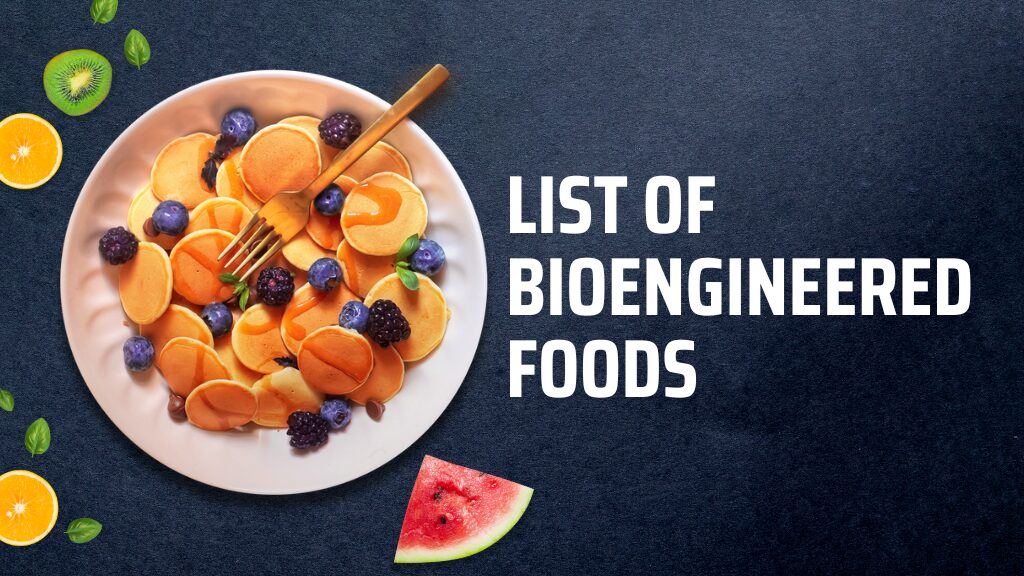In an age where technology intersects with every aspect of our lives, the food industry is no exception. Bioengineered foods, often dubbed ‘GMOs’ (genetically modified organisms), have sparked both curiosity and controversy worldwide. But what exactly are these foods, and how have they changed the landscape of food production? In this article, we will explore the list of bioengineered foods.
Understanding the Basics of Bioengineering in Foods
Bioengineering at its core involves altering the genetic makeup of organisms, including plants and animals, to enhance certain desired traits. This revolutionary technique has given rise to a variety of bioengineered foods, making substantial impacts on agriculture and food production.
The Benefits of Bioengineered Foods
The following are the Benefits of Bioengineered Foods:
- Enhanced Nutritional Value: Bioengineered foods can be fortified with essential vitamins and minerals, addressing nutrient deficiencies prevalent in many parts of the world. This modification can lead to a healthier population overall.
- Improved Crop Resistance: Genetic modifications can make crops more resistant to pests and diseases, reducing the reliance on chemical pesticides and herbicides, thereby minimizing the ecological footprint of agriculture.
- Reduced Chemical Usage: With increased resistance to pests and diseases, there’s a lesser need for applying chemical pesticides and herbicides. This not only helps in reducing the environmental impact but also lowers the production costs and potential health risks associated with chemical use.
- Drought Resistance: Some bioengineered crops are designed to withstand drought conditions, which is increasingly important in many parts of the world facing water scarcity. This leads to better crop yields even in adverse weather conditions.
- Increased Crop Yield: Higher yields are a critical benefit, especially in the context of the growing global population and increasing food demand. Bioengineered crops can produce more food per acre compared to traditional varieties.
- Reduced Carbon Footprint: By increasing crop yields and reducing the need for tillage and chemical applications, bioengineered foods can contribute to a lower carbon footprint of agricultural practices.
- Preservation of Natural Habitats: Higher-yielding GMO crops can potentially reduce the need to convert wildlands into agricultural land, thereby preserving natural habitats and biodiversity.
- Improved Shelf Life: Some GMOs, like certain varieties of bioengineered apples and tomatoes, have been modified to have a longer shelf life, reducing food waste and enhancing food security.
List of Bioengineered Foods
Here is the List of Bioengineered Foods:
- Soybeans
- Corn
- Cotton (used in food-related products)
- Canola
- Sugar Beets
- Papaya
- Squash (Yellow Summer Squash and Zucchini)
- Apples
- Potatoes
- Salmon (AquAdvantage)
- Rice (Golden Rice)
- Tomatoes
- Alfalfa (used for animal feed)
- Eggplant (specific varieties such as Bt brinjal)
- Sugar Cane
Let’s explore each item on the list of bioengineered foods and their specific characteristics or modifications:
Soybeans:
Bioengineered soybeans are often modified for herbicide resistance, allowing farmers to use specific herbicides that kill weeds without harming the crop. This results in higher yield and easier weed management.
Corn:
Genetically modified corn varieties might have traits like pest resistance (e.g., Bt corn which produces a substance toxic to certain pests) and herbicide tolerance. These modifications enhance crop protection and productivity.
Cotton:
While not a food itself, bioengineered cotton is significant in the food industry, especially in cottonseed oil. It is commonly modified for pest resistance and herbicide tolerance.
Canola:
Engineered for herbicide tolerance, bioengineered canola allows for more effective weed control. This leads to a more efficient production of canola oil.
Sugar Beets:
Modified primarily for herbicide tolerance, bioengineered sugar beets enable farmers to control weeds more effectively, thereby increasing the efficiency and yield of sugar production.
Papaya:
The bioengineered Rainbow and SunUp varieties of papaya are resistant to the Papaya Ringspot Virus. This modification saved the papaya industry in Hawaii from devastation by this disease.
Squash (Yellow Summer Squash and Zucchini):
Some varieties of squash have been modified for virus resistance, specifically to combat the cucumber mosaic virus, the watermelon mosaic virus, and the zucchini yellow mosaic virus.
Apples:
Certain apple varieties like the Arctic Apple have been modified to resist browning when cut or bruised. This is achieved by silencing the genes that case oxidation in apples.
Potatoes:
Bioengineered potatoes can have various modifications, such as reduced bruising and black spots, lower acrylamide levels when fried (a potential carcinogen), and resistance to certain pests.
Salmon (AquAdvantage):
This is a type of Atlantic salmon modified to grow faster than non-engineered farm-raised salmon. It achieves faster growth through a modified growth hormone gene.
Rice (Golden Rice):
Scientists have genetically modified this variety of rice to produce beta-carotene, a precursor of vitamin A, intending to help address vitamin A deficiencies in some countries.
Tomatoes:
Bioengineers modified the Flavr Savr tomato, the first commercially available GMO, for a longer shelf life. Although it is no longer on the market, it paved the way for further research into bioengineering in fruits and vegetables.
Alfalfa:
Bioengineers modify alfalfa, primarily used for animal feed, and herbicide tolerance, assisting in weed control during cultivation.
Eggplant (specific varieties such as Bt brinjal):
In some countries, eggplant has been modified to resist pests. For example, Bt brinjal, popular in Bangladesh, contains a gene from the soil bacterium Bacillus thuringiensis, which provides resistance to the brinjal fruit and shoot borer.
Sugar Cane:
Some varieties of sugar cane have been genetically modified for herbicide tolerance, improved sugar content, and disease resistance, aiding in more efficient sugar production.
Bioengineered Foods and Health: Understanding the Myths and Facts
There’s a lot of misinformation surrounding the health impacts of bioengineered foods. Scientific studies have consistently shown that these foods are as safe as their non-engineered counterparts. Common myths about health risks are largely unfounded, with numerous global health organizations endorsing the safety of bioengineered foods.
Conclusion
Bioengineered foods represent a significant leap in food production technology. While they offer numerous benefits, it’s essential to continue monitoring their impact on health, the environment, and society. The ongoing debate and research will undoubtedly shape the future of our food systems. Read more on copypastequickly.
FAQs
Are bioengineered foods safe to eat?
Yes, according to numerous health organizations, bioengineered foods are as safe as their non-modified counterparts.
Can bioengineered foods help in reducing environmental impact?
Yes, by requiring fewer pesticides and other resources, they can have a lower environmental footprint.
Do bioengineered foods taste different?
Generally, they do not taste different from non-modified foods.
Related Post:





